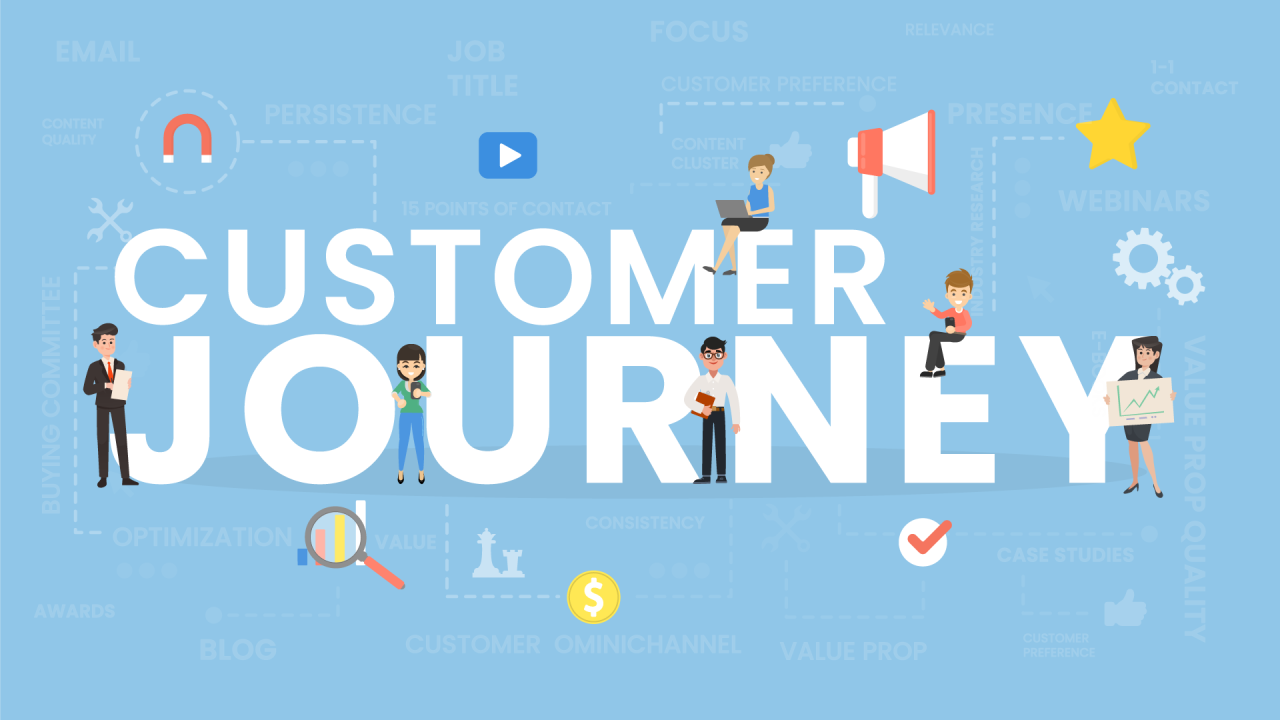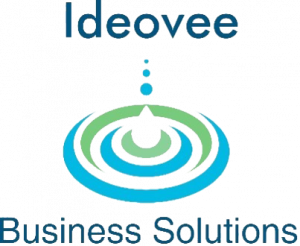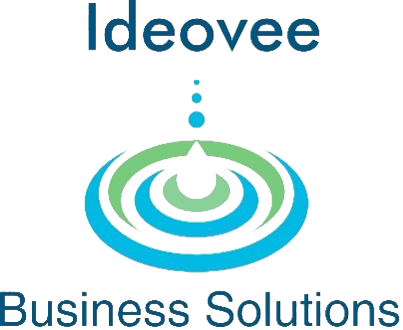
“86% of buyers will pay more for a better customer experience.” Customer Experience Impact Survey
~~~~~~~~~~~~~~~~~~~~~~~~~~~~~~~~~~~~~~~~~~~~~~~~~~~~~~~~~~~~~~~~~~
What is our ABM customer journey?
Our ABM customer journey contains a few essential elements. To describe them in chronological order, the stages are:
- Awareness-> Create the awareness for our customer of the problem we solve and be a familiar and trusted name when the customer searches for the answer to their business problem and encounters our solution and products.
- Search->Conscious of the problem they face, our potential customers start their search for solutions. Our goal at this stage is being easily discoverable as a reliable, credible source of solutions for the problem.
- Consideration->Now we’re under consideration as one of the solutions to our customer’s problem. Our potential customer is actively researching solutions and comparing our product to our competitors’ products. This is where expertise, familiarity and trust can tip credibility toward our solution. The potential customer is actively visiting websites, reading product and company reviews, scouting other informational websites, and examining ads and marketing material. They may also be looking for a tangible, hands-on experience or a live or online demo.
- Decision->The potential customer is wrapping up the evaluation stage and likely seeking buy-in with the buying committee at our customer’s business. For a complex sale, there’s anywhere from 6~10 stakeholders involved in the purchase decision. This is the time to get our customer ready to commit to our solution.
- Retention->Getting new customers is five (5) times more expensive than retaining our existing customers. Retention is a critically important element. This is the time to be proactive, ask for referrals, re-engage our customers for upsells, renewals and sale of related products. Be that complete solution provider to the extent our products are the solution for our customer. During the retention stage the customer evaluates their experience with our business. This is a critically important stage: our opportunity to build and reinforce brand loyalty as their preferred vendor.
- Advocacy->Possibly a subset of retention, will our customer provide a case study or referrals for our business? This develops our customer’s into committed, loyal customers willing to express their loyalty and advocate for the benefits of our solution.
What is the value we create for this prospective customer? Our objective is to educate our prospects on the problem we solve and why they should care (in their own self-interest). Standalone campaigns are ineffective for this purpose. We need sustained presence with consistent, customer-focused messaging and content. It’s time to create awareness of the problem and the value of our solution over the other alternatives in the market. This is the customer journey leading to a purchase decision and ultimately repeat business. We create an interest, desire to buy from us, revenue and a valued customer for the life of our business.
How do we deliver our ABM customer journey and what’s the role for omnichannel outreach?
We start with a customer-centric approach and ask, “where and how do our customers prefer to get their industry information?” With our first attempts, our hunches were imperfect, so we covered a wide array of channels and venues to reach our customers. With ABM measurement (ABM 7, next month’s article) we measure effectiveness of the channels to refine our investment and resources to the most effective channels.
With an omnichannel approach, and with input from sales and marketing, we plan an integrated, consistent product and brand message across all channels. No matter where our customers see our messaging and content, the campaign look, messaging, colors and value communication are consistent. That reinforces our problem definition, product message, solution value and visual brand presentation in the market for our customers.
As part of the plan and foundationally for ABM 7: Measurement, we think through how to collect and evaluate new customer data gathered from the customer journey. It helps us become more effective in delivering a superior experience for our customers. And for future campaigns, the insight enables us to deliver results faster with a decreased sales cycle, because we measurably know what works for customers in our market and what doesn’t. The revenue team (spanning marketing, sales, business development, operations and finance) must be onboard with the martech and sales-tech tools to deploy. We want to gather performance data from all the channels in the customer journey and integrate them into our tools for access across all functions of our revenue team. A key goal is accurate data for analytics so we can best assess allocation of time, resources and return: ultimately in terms of satisfied customers, revenue and profitability.
Consistency is key. With the scope of devices and size formats, this is not a simple task. The messaging and content have to appear to be from the same source in a consistent manner. That amplifies the impact of the messaging; and connotes reliability, credibility, quality and clarity of communication. No matter where a customer sees us throughout the journey, the message will resonate with consistency and clarity.
It aims to identify all the different channels a customer uses, collecting data to understand how, why, and when they might interact with a brand. Once this research is done, the task is to create a personalized customer experience that’s entirely seamless, meeting all of the customer’s needs in the most integrated and unified way possible.
Find our customers where they find their information. Depending on the market the focus may be digital or a hybrid of digital and traditional marketing venues.
What are the critical elements of our ABM customer journey?
An ABM customer journey works best with omnichannel coverage. With input from our sales team who know our customers from in-person experience consider the following elements for coverage:
- Email invitations to industry events (in-person, or virtual)
- Ad presence (online and trade print)
- Website and landing page personalization
- On-demand content relevant to the customer
- Direct mail
- Trade events (presence, and in-person meetings)
- Webinars (featuring an industry celebrity)
We must choose our channels wisely. Respect our prospect and the channel. Gary Vaynerchuck framed this best with: “If content is king, then context is God.”
High level, plan for the interactions with the prospects identified in our campaign. For an example of a high level 11-week customer journey plan here’s a sample outline:

With ABM, we focus on the field feedback from our sales team and conversion rates with prospects from step-to-step in their customer journey to continuously refine our messaging for a specific campaign. We want to derive superior customer experiences by driving insight and value throughout the customer journey and lifetime relationship with us as their preferred vendor.
We strive for that balance of tools and scale and high-personalize and contextual relevance to reach our customers. ABM is, after all, fishing with a spear not a net. We focus on the customers that matter and learn their business, challenges and preferences in depth to develop a long-term business relationship based on trust with them.
Omnichannel elements of our customer journey offer opportunities for deep customer, connection and conversion data. That helps us continually improve our customer journey. We want that insight into the preferences of our customers, their buying committees and requirements. This will help us streamline our sales process, present a superior customer experience and forge customer relationships that endure.
We can optimize the journey to match our budget, resources and goals: ever-improving to help customers see the value and comfortably trust in making their purchase decision. We have to monitor the interaction with our customers as they may shift their focus and channels for information as the sales process progresses. Where they looked for information during the Search phase may be very different in the Decision phase of the customer journey.
There are a few points to keep in mind for our ABM Stage 6-Customer Journey:
- Focus on our buyer’s pain points, that’s where our solution meets their needs
- Craft the messaging and campaigns with the flexibility to be highly personalized for the contacts at each particular account
- Consider the buyer’s experience during each step of the journey including engagement and intent
- Include a call to action and make the journey educational, content rich and consequently valuable to our prospective customer
- Create a scalable yet individualized/personalized experience for our customers
- Frequency of contact, balance the interval of communication with the value offered
Summary
We strive to comprehensively include all ABM practices, resources, data collection, martech, channels, and tools in every ABM campaign. ABM is not a once and done practice, it’s a commitment to a strategic revenue process that aligns marketing, sales, business development, finance and operations to secure customers for the long-term benefit for our company and to our customers.
The customer journey is a sustained and perhaps the lengthiest of the seven steps in our ABM process. Our ABM customer journey is part of a long-term sales, business development and marketing strategy designed to cultivate the right accounts and the right people at those accounts as long-term customers. This is the marathon phase of the process, where we deliver the repeated contact required to establish trust, build credibility and persuade our prospective customer to purchase our solution. There are elements of customer nurturing with a goal of maturing the marketing qualified leads into sales qualified leads in a scalable, methodical journey that educates, persuades and adds value for our prospective customers.
Written by Betty Ledgerwood, Principal of Light Switch Marketing, Inc. and Murray Vince, VP, Business Development, Ideovee Business Solutions LLP.
Our next ABM article will focus on Step 7: Metrics, that article will be published in July. Please drop us an email here at HYPERLINK “http://mailto:support@betterprospecting.biz/” \h support@betterprospecting.biz if you want a notice about when our new ABM blogs are released.
Thanks to Simran Preet, Harshdeep Singh, and Rocco Chappie for their suggestions and edits. Any errors or omissions are solely mine.
BetterProspecting™ offers templates to guide the account selection process for B2B sales. BetterProspecting™ also offers ABM business analyst research and support, training and coaching for the sales team to help better focus resources, time, effort and staff on developing the customers that matter most to the business.
For more information, visit https://betterprospecting.biz/

Resources
B2B Buying Process Explained: How To Help Your Customers Make Buying Decisions (forbes.com), B2B Buying Process Explained: How To Help Your Customers Make Buying Decisions, Sep 13, 2021,07:00 am EDT, By Samuel Thimothy, VP at OneIMS.com “Typically, the B2B buying group consists of six to 10 decision-makers, each armed with four to five pieces of information they’ve gathered independently, and all must communicate with one another to figure out whether they should buy the solution.”
The B2B Buying Journey | Sales Insights | Gartner.com, The B2B Buying Journey, The B2B buying process has changed, has your sales strategy?, “The customers buying journey is hard
The typical buying group for a complex B2B solution involves six to 10 decision makers‚ each armed with four or five pieces of information they’ve gathered independently and must deconflict with the group.” Gartner Inc.
Is Acquiring New Customers More Expensive Than Keeping Them? – The European Business Review, Is Acquiring New Customers More Expensive Than Keeping Them?, January 30, 2021

